Excerpts from Jim Conrad's
Naturalist Newsletter
from the July 2, 2017 Newsletter issued from Rancho Regenesis in the woods ±4kms west of Ek Balam Ruins; elevation ~40m (~130 ft), N20.876°, W88.170°; north-central Yucatán, MÉXICO
ADDING CHARCOAL TO COMPOST
At the ranch, animals produce plenty of manure, which is gathered, mixed with compostable refuse and charcoal, and composted. The manure mixes with a fair amount of limestone-derived mineral soil, so that's included, too.
At www.backyardnature.net/compost.htm our compost page doesn't mention charcoal being mixed in, and it doesn't occur to most of us to add charcoal. However, here a good bit of brush and small trees get cut when building trails, opening up planting areas, and such, and the owner looked into what could be done with all that dead wood, other than let it decay where it fell, which also was a good idea. After studying the matter on the Internet, she decided to convert the larger woody pieces to charcoal, grind the charcoal into small pieces and black dust, and add it to the compost. In some places, instead of calling what's produced charcoal, it's given the name "biochar."
At http://www.biochar-international.org/compost a page sums up how adding biochar benefits the composting process:
"Based on current findings, the benefits of adding biochar to the composting process may include shorter compost times; reduced rates of GHG {greenhouse gases} emissions (methane, CH4 and nitrous oxide, N2O); reduced ammonia (NH3) losses; the ability to serve as a bulking agent for compost; and reduced odor. For the biochar material itself, undergoing composting helps to charge the biochar with nutrients without breaking down the biochar substance in the process."
Biochar starting out as charcoal isn't the same as wood ashes you might have from a fireplace or grill. The main difference is that a fireplace's ashes result from a nearly complete burning of the wood, while biochar from charcoal has been produced with controlled burning, which blackens the wood and converts some of the cell contents to gases, but leaves much of its woody cellular structure in place.
Also, wood ashes from fireplaces and grills are always a little suspect because they may contain residues of igniting fluids or other chemicals that shouldn't go into compost. You wouldn't use ashes from a demolished sundeck because probably the wood had been treated with chemicals to retard decay.
Otherwise, if you're sure that your wood ashes are chemical free, it may be a good idea to add them to your compost. Ashes contribute potassium, lime and other important trace elements. Also, if your soil is a little acid, ashes tend to increase the pH -- help maintain the neutral condition. But, too much ashes may actually restrict the availability of other important nutrients. Mix it with the compost and soil, but don't apply ashes directly, unless you're trying to de-acidify your soil.
from the July 2, 2017 Newsletter issued from Rancho Regenesis in the woods ±4kms west of Ek Balam Ruins; elevation ~40m (~130 ft), N20.876°, W88.170°; north-central Yucatán, MÉXICO
MAKING CHARCOAL FOR COMPOST
Here at the ranch a special metal-drum stove has been constructed for making charcoal. The stove's design was found in a permaculture book. Below, you can see my Maya friend Gener at the beginning of the charcoal producing process:
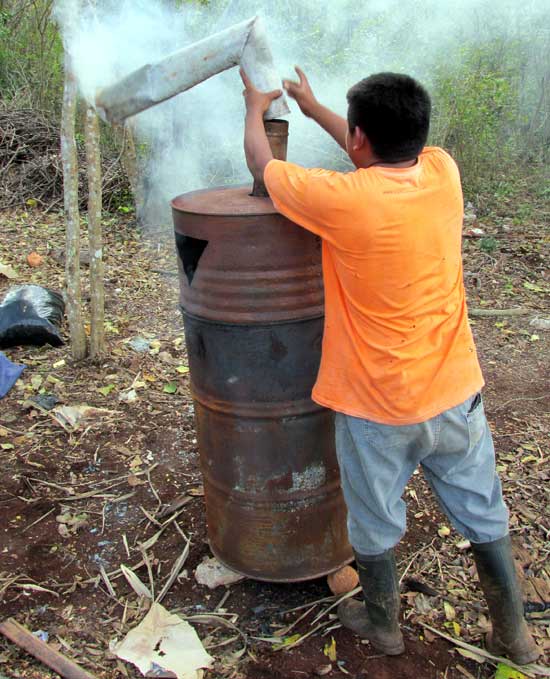
I've wondered if the L-shaped chimney really is appropriate for a stove being used outside, but when such designs are found in books written by experts, you hesitate to fiddle with them. Below, you can see the stove's top, with bottom flanges that fit inside the larger, lower drum:
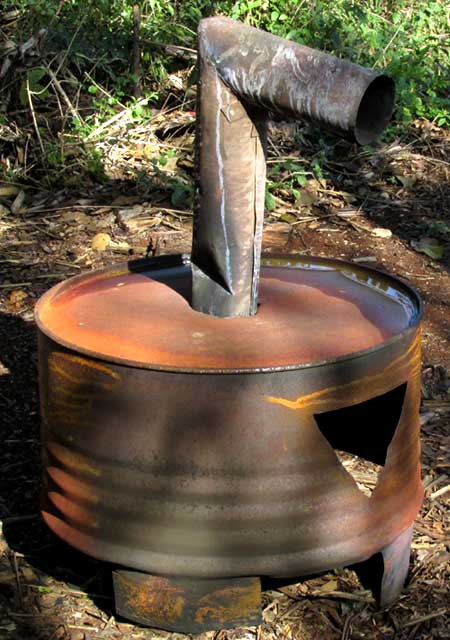
So, the bottom metal drum is stuffed tightly with dry chunks of wood, mostly not thicker than my wrist. A fire is started atop the wood, normally with a little help from some dry cardboard, wood shavings, or whatever is on hand for starting fires. Once the wood's top is burning, the stove's cover section pictured above is added, with air able to enter through the cover's large, triangular hole. That hole apparently allows enough air to enter to keep the fire going, but it's not so large that the wood burns vigorously enough to completely convert the wood powdery ashes. Gradually the fire spreads down through the wood. This descent of the fire is possible because the lower drum's bottom is slit to permit air to enter from below, as shown below:

In the first picture you may have noticed that the whole assembly rests atop rocks, enabling air easily to enter the slits.
As fire spreads downward through the wood, Gener occasionally splashes the drum's sides with water. If fire has reached halfway down, then above the halfway mark the water will hiss and turn to steam. Once splashed water forms steam at the bottom, then it's time to shut off the stove's air, as Gener is doing below:
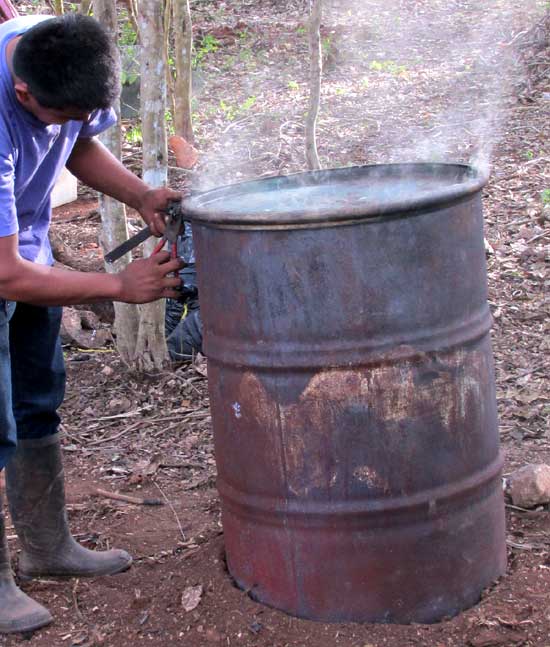
Note that the drum has been removed from its rocks, soil is banked up against the bottom to form a better seal, and the top lid is being clamped down so that really no air can get to the burning wood. With no air, the fire almost entirely dies, but not quiet. It continues smoldering for a good while, and this very slow smoldering process is what produces charcoal instead of ashes. Below, you can see a bag of charcoal produced in this stove
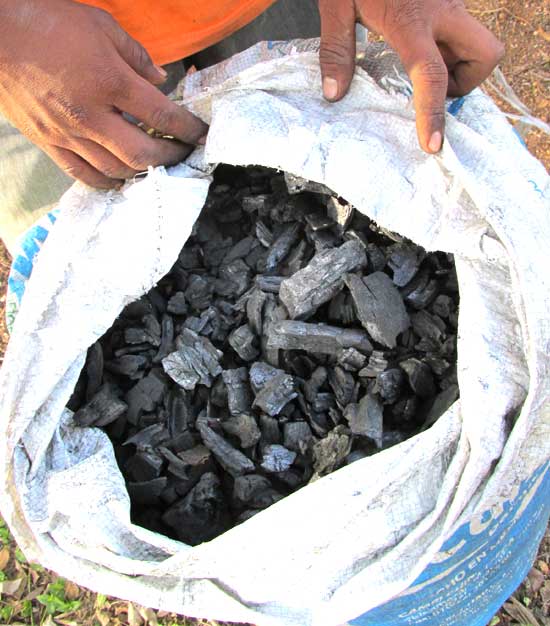
Before the bagged charcoal is added to the compost, it's stomped, beat with a shovel and otherwise abused until it's converted to small pieces maybe the size of a thumbnail, down to pure dust, and then it's mixed into the compost.
By the way, I always keep pulverized charcoal handy for medicinal uses, especially for tourists who come with diarrhea and upset stomachs. Just mix maybe half a cup of charcoal powder in a glass of water and drink. The charcoal absorbs toxins in the gut while resisting digestion, and eventually passes outside the body, from one end or the other. Below, you can see my grinding operation for producing charcoal dust:
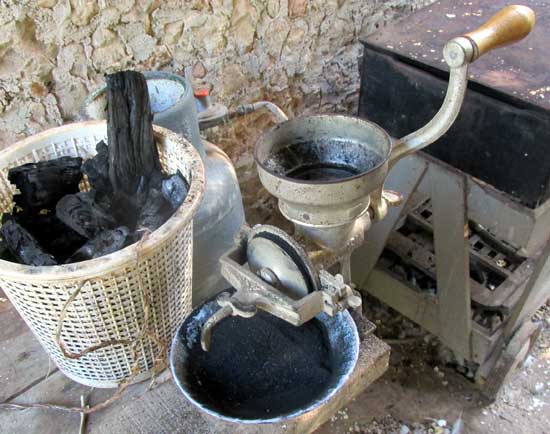
That grinder also makes a fine cornmeal from dried, locally produced corn. Back on the farm in Kentucky sixty years ago we used a similar one for grinding sausage. Such grinders are wonderful.